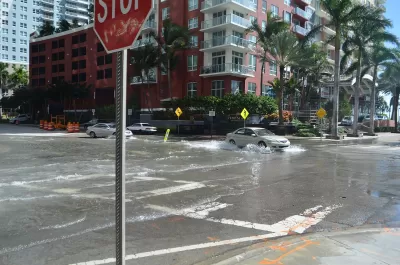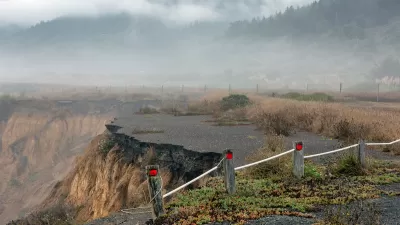As climate change accelerates sea level rise and flooding in South Florida, locals hope to mitigate the impacts with less dramatic interventions.

In the first draft of a federal study seeking ways to "protect the vulnerable South Florida coast from deadly and destructive storm surge," the U.S. Army Corps of Engineers proposes building a six-mile inland seawall–and not everyone is happy about the plan, reports Patricia Mazzei for the New York Times. "[T]he startling suggestion of a massive sea wall up to 20 feet high cutting across beautiful Biscayne Bay was enough to jolt some Miamians to attention: The hard choices that will be necessary to deal with the city’s many environmental challenges are here, and few people want to face them."
The problem in Miami, writes Mazzei, is not denial, but the sheer magnitude of the challenge. "None of the possible solutions are cheap, easy or pretty," and storm surge is just one of the concerns exacerbated by climate change. "Even when there is no storm, rising seas contribute to more significant tidal flooding, where streets fill with water even on sunny days. The expanding saltwater threatens to spoil the underground aquifer that supplies the region’s drinking water, and to crack old sewer pipes and aging septic tanks. It leaves less space for the earth to absorb liquid, so floodwaters linger longer, their runoff polluting the bay and killing fish."
Yet opposition to the seawall proposal "has produced a rare moment of agreement between environmentalists and real estate developers, who fear harm to the bay’s delicate ecology and lower property values." Miami-Dade County wants to prioritize the less controversial "[o]ther parts of the corps’s draft plan, which includes surge barriers at the mouth of the Miami River and several other waterways," "fortifying sewer plants and fire and police stations to withstand a crush of seawater," "[e]levating or flood-proofing thousands of businesses and homes," and planting mangroves to defend against erosion and flooding.
Locals tend to agree with taking more measured steps. "In fact, when local governments have asked the public how they would like to tackle climate change, residents by far prefer what is known as green infrastructure: layered coastal protection from a mix of dunes, sea grasses, coral reefs and mangroves, said Zelalem Adefris, vice president for policy and advocacy at Catalyst Miami, which works with low-income communities in the county."
Army Corps officials insist that, with the current pace of climate change and sea level rise, "they see no way around what they call structural elements." Niklas Hallberg, the study’s project manager, "said the corps is committed to working with the community in the next phase of design for the project, so 'maybe it doesn’t look like so much of a wall.'"
FULL STORY: A 20-Foot Sea Wall? Miami Faces the Hard Choices of Climate Change.

Alabama: Trump Terminates Settlements for Black Communities Harmed By Raw Sewage
Trump deemed the landmark civil rights agreement “illegal DEI and environmental justice policy.”

Planetizen Federal Action Tracker
A weekly monitor of how Trump’s orders and actions are impacting planners and planning in America.

How Atlanta Built 7,000 Housing Units in 3 Years
The city’s comprehensive, neighborhood-focused housing strategy focuses on identifying properties and land that can be repurposed for housing and encouraging development in underserved neighborhoods.

In Both Crashes and Crime, Public Transportation is Far Safer than Driving
Contrary to popular assumptions, public transportation has far lower crash and crime rates than automobile travel. For safer communities, improve and encourage transit travel.

Report: Zoning Reforms Should Complement Nashville’s Ambitious Transit Plan
Without reform, restrictive zoning codes will limit the impact of the city’s planned transit expansion and could exclude some of the residents who depend on transit the most.

Judge Orders Release of Frozen IRA, IIJA Funding
The decision is a victory for environmental groups who charged that freezing funds for critical infrastructure and disaster response programs caused “real and irreparable harm” to communities.
Urban Design for Planners 1: Software Tools
This six-course series explores essential urban design concepts using open source software and equips planners with the tools they need to participate fully in the urban design process.
Planning for Universal Design
Learn the tools for implementing Universal Design in planning regulations.
Caltrans
Smith Gee Studio
Institute for Housing and Urban Development Studies (IHS)
City of Grandview
Harvard GSD Executive Education
Toledo-Lucas County Plan Commissions
Salt Lake City
NYU Wagner Graduate School of Public Service





























